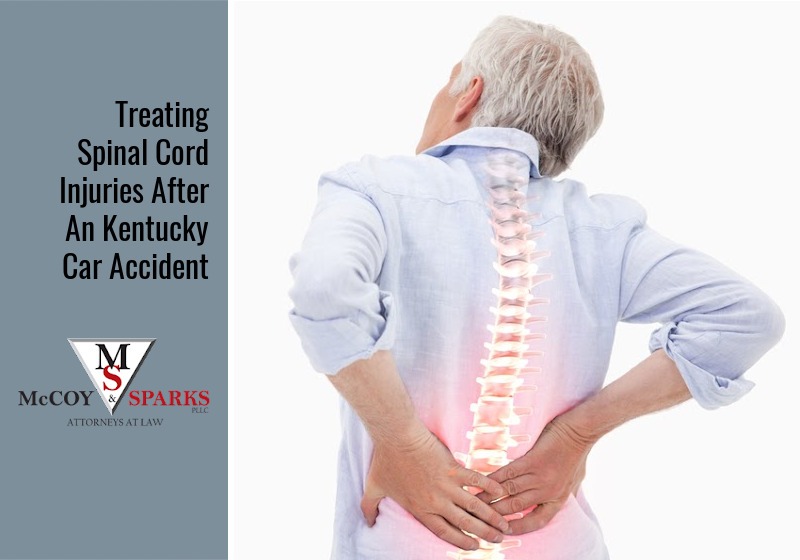
The spinal cord is a collection of nerves and nerve tissues that are housed in the spine. It runs from the base of the skull to the lower back and carries messages from the brain to the rest of the body. An injury to the spinal cord can be catastrophic, possibly causing partial or even full paralysis.
Causes Of Spinal Cord Injuries:
Motor vehicle accidents are the most common cause of spinal cord injuries, but there are many other causes. According to the National Spinal Cord Injury Statistical Center (NSCSC), the leading causes of spinal cord injuries since 2015 have been:
- Motor vehicle accidents 39.3%
- Slips and falls 31.8%
- Violence 13.5%
- Sports and athletic pursuits 8.0%
- Surgery (including malpractice) 4.3%
- Other 3.1%
A Few Facts and Statistics About Spinal Cord Injuries:
- In 2017, 245,000 – 353,000 Americans were estimated to be living with spinal cord injuries.
- The average age of a spinal cord injury survivor is 42.
- In Kentucky, the rate of nonfatal spinal cord injuries in 2019 was 6.1 per 100,000 people.
- Patients who stayed in the hospital in Kentucky after suffering spinal cord injuries stayed anywhere between 1 day to 58 days. The mean length of stay was 10.6 days, and the median length of stay was 8 days.
- The Kentucky Spinal Cord and Head Injury Research Trust (KSCHIRT) was established in 1994, funded by surcharges on Kentucky traffic tickets.
- In the first year after a high tetraplegia (explained below) spinal cord injury, average expenses are $1.079 million.
- The average cost of medical expenses after the first year for a high tetraplegia spinal cord injury is over $187,443.
Definitions Of Common Terms:
There are varying degrees of spinal cord injury, and the amount of future function depends on exactly where in the back the injury occurs.
- The nerves that branch off from the spinal cord are divided into four sections (from top to bottom):
- Cervical
- Thoracic
- Lumbar
- Sacral
- SCI stands for spinal cord injury.
- The SCI is said to be complete if sensations and movement are cut off completely below the place where the spinal cord is damaged.
- The SCI is said to be incomplete if there is any kind of partial function below the injury.
- Tetraplegia is damage in the cervical area that prevents movement below the neck. This is also called quadriplegia. Both tetra and quad are roots that mean four, so these are the terms used when all four limbs are paralyzed.
- Paraplegia begins in the thoracic, lumbar, or sacral areas. People who have this type of spinal cord injury typically can move their arms and hands, but not their legs.
What Happens After You Have Been In A Kentucky Car Accident and A Spinal Cord Injury Is Suspected?
- On the scene of an accident, first responders will use a variety of techniques, such as hard collars, hard boards, blocks, or vacuum mattresses to immobilize your spine and reduce the possibility of further injury.
- In the hospital, doctors will examine your range of movement and ability to sense touch.
- If they suspect an SCI, they will next use one or more of the following tests:
- X-Ray: These can reveal fractures in the spine.
- CT scan: Computerized tomography uses computers to form a series of cross-sectional images of bones and discs.
- MRI: Magnetic resonance imaging uses a magnetic field and radio waves to produce images that show the spinal cord, plus any herniated discs, blood clots, or bone fragments.
- If you do have a spinal cord injury, you will be admitted to the intensive care unit or a spine injury center.
- Once your condition has stabilized, doctors will focus on warding off secondary problems, such as:
- Deconditioning
- Muscle contractures
- Pressure ulcers
- Bowel and bladder issues
- Respiratory infections
- Blood clots
- When you are well enough, you will be discharged to a rehabilitation facility to learn how to manage your injury. You will need adaptive techniques to use in your day-to-day life. Your specialists may include:
- Physical therapists
- Occupational therapists
- Rehabilitation nurses
- Rehabilitation psychologists
- Social workers
- Dietitians
- Recreational therapists
- Doctors who specialize in spinal cord injuries
- You may not receive a prognosis immediately. Recovery typically begins a week to 6 months after your injury. Some people experience small improvements for up to 2 years.
- Depending on the severity of your SCI, you may need adaptive equipment and some structural changes in your home.
A spinal cord injury is a life-changing event. You will need to focus all of your energy on your recovery and rehabilitation. The last thing you should have to worry about is proving how you were injured or even the extent of your lifetime of damages. Leave that up to your personal injury attorney.
Trust McCoy & Sparks – Premier Personal Injury Attorneys in Central Kentucky
Recognized as one of Central Kentucky’s best law firms for over a decade and counting, McCoy & Sparks works to help people in trouble, representing thousands of clients in Central Kentucky with a focus on providing premium service and delivering superior results. We have handled numerous cases involving clients with severe SCI. Regardless of the type of case, our goal is to develop a strategy that best serves your personal needs, then draws upon our courtroom skills to help you reach the best possible result. We start by getting to know you. Next, we will explain all of your options, giving you the pros and cons of each choice so that you will be empowered to make informed decisions. You owe us nothing unless we recover compensation for you.
Make the right call to 1-844-4KY-WINS for a risk-free consultation with one of our attorneys today

